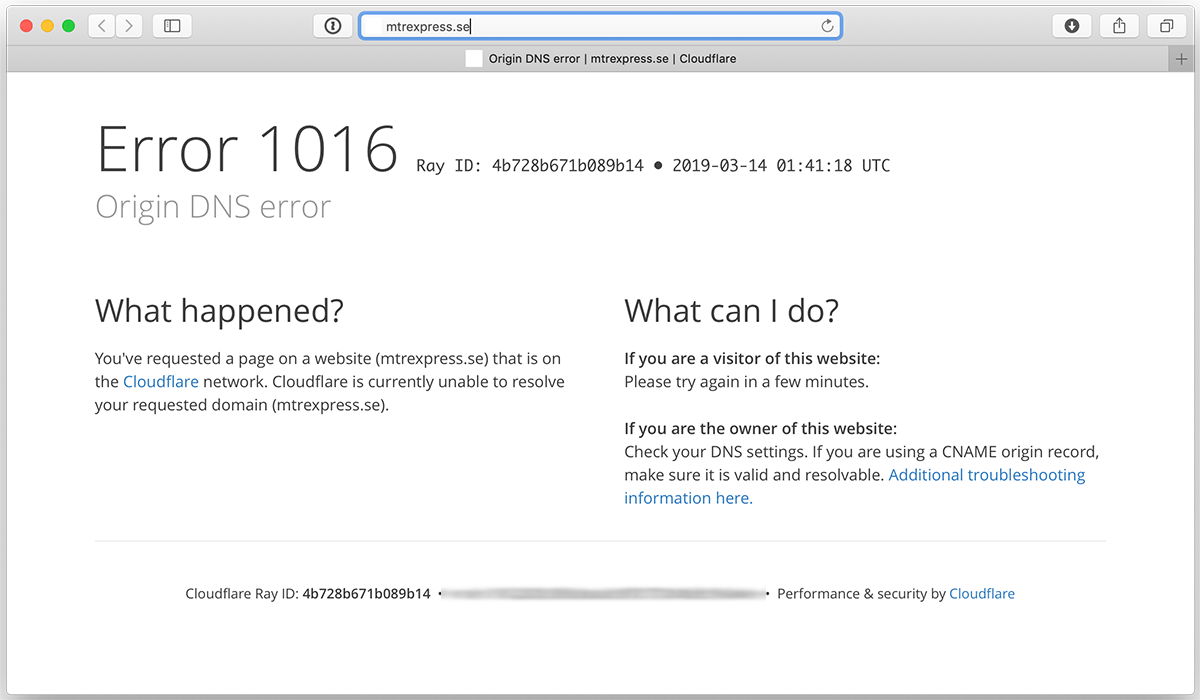Suddenly gone — where’s my website?
The Swedish passenger train company MTR Express recently found themselves cut off from their customers. Their website, where people book travel on their trains, was gone.
MTR Express is one of the passenger train operators between Sweden’s 2 largest cities: Stockholm and Gothenburg. Have been for several years. Tickets are mainly sold through their mobile app and their website.
But as of February 28 this year, when you go to their website at mtrexpress.se, you are met with a blank page. Absolutely nothing there. Except today, I get an error message there. Still not helpful.
The company notified the world via Facebook that users should remove MTR’s app from their phones, because it’s no longer working. They then directed would-be travelers to a totally new website at https://mtrexpress.travel/sv But Google still sends searches to the URL above. Ouch.
What happened to cause this drastic change? When a business has had a domain for several years and has built up search engine rankings, they surely wouldn’t abandon it just like that.
They didn’t.
The drastic change is the result of a conflict with their now former IT company. As it turns out, their domain mtrexpress.se (and another domain they used) is registered by the IT company.
Key concept to remember: The organization that registers a domain, owns it and controls it. Regardless of if that’s the company or organization the domain really represents.
MTR Express had the folks that developed their website register the domain, instead of doing it themselves, in the IT company’s name. So in the domain records, mtrexpress.se belongs to the IT company. Not MTR.
Let that sink in for a moment.
This has led to MTR Express having to set up a new booking website literally overnight. Plus they’re now suing their old IT company. I have no idea why they parted ways to start with. It’s probably been brewing for some time. Not at all addressing who may be at fault in that disagreement, because I have no insight into the particulars.
But when things blew up, all of a sudden a company that relies on their website for doing business every day was instantly cut off from that website. They ceased to exist. People got a blank page at their web address. No redirection. No information.
That’s disastrous. Because how do you tell prospective customers you’ve moved when you can’t reach them?
I have no idea what it cost MTR Express to, in an extreme rush, set up a new domain, website and booking system. Or to try to get back in front of their target audience. Just know it’s definitely not cheap.
Especially not when about weeks after the fateful day, Google still sends search traffic to their defunct site.
An online presence takes time and effort to build. And can be ruined overnight.
But of course, this could never happen to you and me. Right?
Wrong. I’ve worked with an organization to do the cleanup when things went south with their former web developer and hosting company. Eventually we did get control of the old domain again, but not until well after a new website had been launched on a new domain.
How do you make sure this kind of devastating interruption doesn’t happen to your business or organization?
Here are 5 absolutely key steps:
Own your domains
MTR Express for some inexplicable reason allowed their IT company to register their domains for them. Remember, whoever registers the domain, controls it. And legally owns it. A court may eventually decide that the domain rightfully belongs to the company it goes with. But that’s time and money lost. Damage done.
So register your domain yourself. In your name. Now you own it. Period. Ever since I started building websites, that’s what I’ve told clients. I’ll gladly help clients register their domain. But I want them to own it.
Never mix domain registration and website hosting
It sounds so convenient and lots of vendors offer it: Get your domain from the company that also hosts your website. Just deal with one account. What’s not to like?
How about the fact that having both in one place will cause a major headache if you ever for any reason need to change registrar or hosting company?
It’s not unusual to do that either over a period of years. That hosting package that was perfect when you started out may turn out to be really limiting after a few years. Now you want to move. To another company. But your domain is registered at the hosting company. Things get complicated. You’re looking at some downtime for your website while things switch over.
If registration and hosting are with separate entities, then switching hosting is a simple process of getting everything ready with the new vendor and changing where the domain points. Seamless.
Likewise moving a domain registration to a new registrar is also easy, with little interruption, when that doesn’t involve changing hosting at the same time.
Get your name as a domain, even if you don’t plan to use it right now
This especially applies to entrepreneurs and small business owners. When I started my company, it was called Film & Company LLC. Even so, I registered ClaesJonasson.com. Just because it was available. When the .design suffix became available, I registered ClaesJonasson.Design as well. By then, I was already working on rebranding. Eventually I went with Claes Jonasson Design LLC. Which was easy, because I already owned the domain.
If you don’t own your name as a domain, somebody else is probably going to pick it up, sooner or later. At which point, it may be really confusing for your customers.
Renew your domain before it expires
When a domain expires, there’s usually a (short) grace period before somebody else can register it. But don’t rely on it.
Do count on that if your website had any level of traffic, somebody out there will snap up your expired domain just to try to make a few $$ running ads on it. Because there was traffic coming to it. They may tire after a while and let it go again. But you can’t get it back in the meantime. Unless of course you outright purchase it from the new owner. Who may suddenly realize they’re sitting on a small gold mine. Needless to say, you won’t get it back for the $20 or so it would have cost to just renew the domain registration on time.
Use a domain registrar that is going to be around
Not all domain registrars are created equal. Some are nothing more than repackagers of somebody else’s service. In that case, who is your domain really registered with? Who is going to be there for you if there’s a problem? While none of us can guarantee the future, doing some homework before selecting a company to register your domain with, can avoid issues later on.
Follow these 5 steps and you’ll truly be in control of your website domain registration. There are plenty of other things that can go wrong online. But you’ll know that your domain is yours and you own it.
Because at the end of the day, your website will represent who you are and be your connection hub with your audience. You definitely don’t want to lose search engine rankings over something as silly as changing the web hosting company or domain registrar.
You certainly don’t want to be in the position of MTR Express that is now working through the court system to get their domains back. That’s time and money neither you nor I have.
Never miss out!
Get an email update every time I publish new content. Be the first to know!

